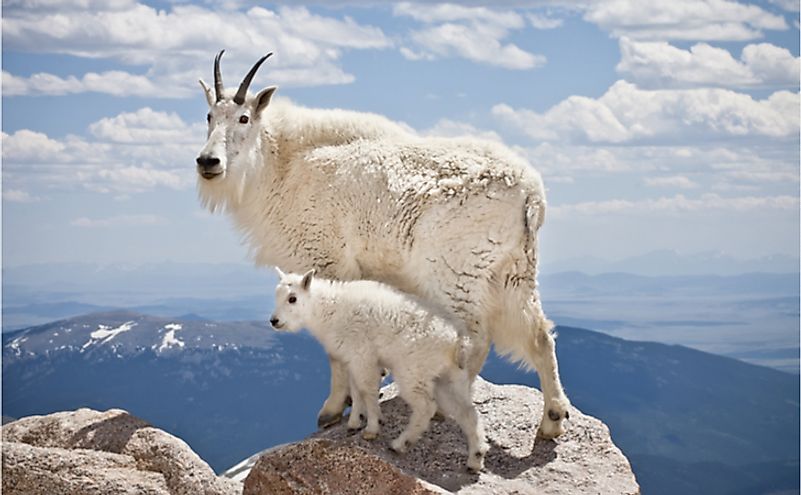How Is The Mountain Goat Adapted To Its Environment?

Mountain goats are found in the mountains of Canada and the United States. They inhabit the steep rocks above the treeline. Despite their name, mountain goats are not members of the genus Capra which includes wild and domestic goats but are instead members of the antelope family. The species is native to North America, and the scientific name Oreamnos Americanus translates to “the mountain lamb of America.” The goats are about three and a half feet tall and weigh between 150 and 230 pounds. It is difficult for a mountain goat amateur to differentiate males (billies) from females (nannies) because they share similar physical characteristics. Mountain goats have survived for thousands of years in their environment due to their adaptive features.
Horns
Mountain goats defend against potential predators using their long, slender and pointed horns. Unlike the antlers of the deer, elk, and moose, the horns of the mountain goats do not shed but grow continuously. Seasonal rings grow annually and can tell the age of a goat. The horns of billies curve slowly along the entire length while those of nannies bend at the tip.
Coat
Mountain goats inhabit high altitudes where temperatures are low and can drop to below freezing point during the winter. Nevertheless, low temperatures are the least of their problems due to the double layer of fur that keeps them warm. The fur covers the entire body except for the head and toes. By late spring towards summer, the goats begin to shed the coats by rubbing against tree trunks and rocks.
Toes
Mountain goats are excellent climbers and can travel further across steep rocks than most animals and humans, thanks to their toes. The hoof on each foot has a bony outer shell and a spongy concave footpad that acts like a suction cup. The toes spread, allowing the animal to move around the mountains with ease. The short, sturdy legs and heavy bodies help the animal gain agility. Mountain goats can leap up to 10 feet and pull themselves from one ledge to the other using their front feet.
Habitat
The mountain goat habitat is unique and allows the animal to thrive. They spend their time at high altitudes in Rocky Mountains all year round, away from most predators. While other animals migrate to lower elevations during the winter, mountain goats do not. They also prefer south-facing slopes where the temperature is slightly warmer during the winter and snow melts faster.
Survival And Aging
Although the cold temperature is not a problem for mountain goats during the winter, they must conserve energy by reducing disturbances and stress, which lower their chances of surviving the harsh weather. For this reason, the goats choose steep caves that cannot be accessed by predators. They have an average lifespan of about 11 years, but older goats occasionally starve because their teeth wear away and they are unable to chew food.
Diverse Diet
The feeding habits of the goats vary throughout the year, depending on the availability of food. Their diet consists of woody plants, grasses, mosses, and lichen. They occasionally visit salt licks though where they draw minerals. The diverse diet helps the animal survive through the winter and summer.
Predators
Mountain goats live in habitats that are difficult to access and do not, therefore, have many predators. The mountain lion is their biggest threat, although golden eagles snatch kids when the opportunity presents. Some people hunt the goats for trophies and meat. A large number succumb to accidental falls, avalanches, and starvation.
Societal Order
Each mountain goat in a herd has a rank which determines who gets the best feeding and sleeping spots, and who uses the salt licks first. Nannies and their kids rank top while billies rank lowest except during the mating season. Older nannies determine where the herd will feed and spend the night due to their experience and knowledge of the terrain.
Behavior
The mating season occurs between November and December. The billies follow the nannies for over a month trying to find the best partner. Half the nannies in a herd give birth to either one kid or two kids during spring when food is plenty. Soon after they are born, kids stand and begin following their mothers around. Within a few days, they can run and escape predators. Nannies teach their kids to traverse the hills and rocks until they are a year old and can take care of themselves.











